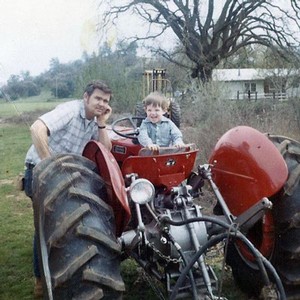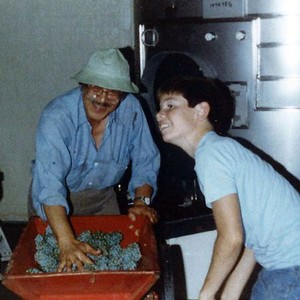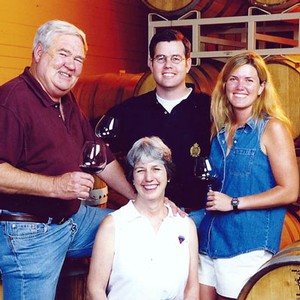History

A Winery is Born
It’s fairly obvious to those that have visited our winery that we didn’t enter the wine business to feed our egos. It wasn’t a lifestyle choice, a summer home, or the need to have our name on a wine label. We were not Hollywood transplants or financial tycoons. Our story is one borne of necessity.
In 1970 my parents purchased 43 acres in the Jackson Valley of Amador County. My father was born and raised on a dairy, grew up farming and caring for the land, but had no direct winegrowing experience. It was recommended that winegrapes would do well on our ranch so they went about planting 30 acres of Zinfandel. This was an era of Martini lunches and bourbon and water. Fine wine was just entering the American conscience.
My father’s entrepreneurial tendencies led him to partner in a fine wine shop in the mid 1970’s. It was through this experience that he discovered his love of wine and particularly the incredible Port wines of Portugal’s Douro Valley. Always the restless sort, he soon had contacted UC Davis to see what Portuguese varieties were available to plant in California. At a time when American growers, vintners, and consumers were just beginning to hear about Cabernet Sauvignon and Chardonnay he planted Touriga, Tinta Cao, Alvarelhao, Souzao, and Bastardo in our Amador County vineyard.
Those first Portuguese grapes ripened in the fall of 1981. They, along with all of our grapes, were sold to a now defunct winery named JW Morris. Shortly after harvest my father received a tip that the winery was going to file for bankruptcy leaving us holding the bag. He quickly set out in his pickup truck to reclaim whatever was decent. Arriving at a nearly deserted warehouse he soon discovered 300 gallons of a young port wine from our Amador County vineyard. He colorfully instructed the reluctant cellar worker to load that wine in his pickup.
Traveling along I-80, bootleg in tow, he soon concluded that he was quite capable of going broke himself, and that he wasn’t going to allow someone else to do it for him. He called a friend who owned a winery and asked if he could store this port for him. He realized that selling a wine bottle by bottle was preferable to going broke, and thus St. Amant Winery was born. At the time, he reckoned that St.Amant, my mother’s maiden name, sounded a lot better on a bottle of wine than Spencer.
That first wine, our 1981 Vintage Port, was a hit and still stands as a testament to all that is possible with these unique varieties in our vineyard.
 The Early Days
The Early Days
Throughout most of the 1980’s we made wine at other wineries, sold grapes, and peddled our wine across the country. Our port-styled wines were always a focus, but we also experimented with red Zinfandel, Zinfandel Blanc (dry rose), Tres Cachos (Portuguese dry red), Sauvignon Blanc, and several other small production wines. There were good, bad, and downright ugly years, but we persevered. In the late 80’s the white Zinfandel craze took off and we had several very profitable years selling grapes. This gave us the resources to open our own winery, where we could control every aspect of production from crushing to bottling.
My dad always seemed to choose the path of most resistance, so we opened our winery in 1990 in French Camp, CA. This was not wine country! And at a time when Americans were just getting comfortable with the French varietal wines, we were focused on Portuguese varieties, port-styled wines, and other obscure wines. Yet we persevered.
 Welcome to Lodi
Welcome to Lodi
In 1992 we began working with the Lodi Winegrape Commission to produce single-vineyard, small production wines for them to market the region. At this point, virtually no Lodi labeled wines were being made and the Commission wanted to showcase the quality of Lodi vineyards by demonstrating their potential with small artisan winemaking.
In 1996 we ended up in a lawsuit with our landlord, and had to quickly move the winery to a new location. This probably saved our business. Fortunately, we found a place in Lodi, and setup shop at the old Guild Winery. This was a post prohibition era winery, built in the late 1930’s, and we took over the old brand bottling warehouse. It was anything but picturesque, but it was functional, and allowed us to continue making our wines.
It was also at this time that our vineyard was dying of phyloxera. And when you are a vertically integrated winery, growing your own grapes, and making your own wine, and your vineyard dies – you’ve got a problem. At this point, my father worked out a deal with the Lodi Winegrape Commission – if a grower brought us 2 tons of grapes, we would make the wine, and give them 25 cases, and keep the balance for ourselves. We had numerous growers take us up on the offer, and then one day Jerry Fry showed up with 7 tons of beautiful Old Vine Zinfandel grapes. My father didn’t know what to do. We didn’t have the money to pay for the grapes, and we had no idea how the wine would turn out. Jerry told him not to worry about it, that we would work it out later. We ended up bottling 450 cases of that first vintage. It won a bunch of awards, sold out quickly, and has since grown to be our most popular wine.
Two years later we added our Leventini Vineyard Barbera, and in 1999 started producing our Marian’s Vineyard Old Vine Zinfandel from Mohr-Fry Ranch. Back then there were only a handful of small vintners in Lodi, consumers had never heard of the region, and you could go days if not weeks waiting for a visitor to come by. But the wines were good, and the word started to spread, and slowly but surely the wine sold and the people came. Now, nearly 20 years later, Lodi is on the map, business is good, and the wines are getting better and better.
 Vineyard Rebirth
Vineyard Rebirth
Throughout the mid 1990’s we meticulously redeveloped our Amador County vineyard, and doubled down on Portuguese varieties. We had learned a lot from our earlier experiences, and set out selecting the best rootstocks, clones, trellising and variety mix to produce the best California versions of these wines. We added several varieties to our vineyard including the Portuguese white Verdelho, and the Spanish Tempranillo, also known as Tinta Roriz in Portugal. And over the years, we have expanded our portfolio of niche wines including a Touriga, Souzao, Verdelho, and a Tempranillo. We perfected and expanded our port making line of wines including a White, Bootleg, Tawny, and our classic Vintage Port. At times, it wasn’t easy, but we believed in our vision and the quality of our wines.
 The Next Generation
The Next Generation
On September 12, 2006 Tim Spencer passed away after a hard-fought two year battle with Lymphoma. He was 68 years old, and was remembered by many for his delicious wines, unique hospitality, and original personality. Three days later we had to pick grapes. There was no other option, and he would have expected us to do no different. 2006 was a difficult harvest, but some great wines were made. We got through it with the help of many friends, family, and colleagues.
In 2006, Tim’s son, Stuart Spencer took over as winemaker for St.Amant. Stuart had worked alongside his Dad for many years in the vineyards and cellars. The winemaking came fairly easy, but making sense of all the paperwork was quite the challenge. Needless to say, St.Amant has prospered, and continues to make distinctive, original, hand crafted wines that reflect the place they came from and the people that made them.